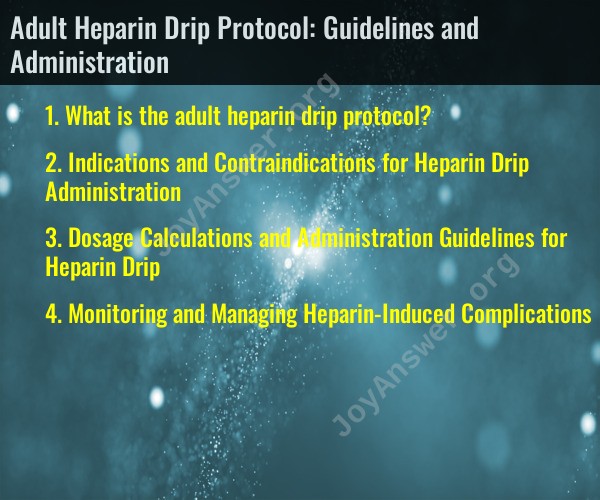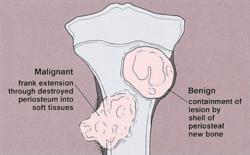What is the adult heparin drip protocol?
The adult heparin drip protocol outlines guidelines for the administration of intravenous (IV) heparin in adult patients. It is crucial to note that specific protocols may vary between healthcare institutions, and medical professionals should always adhere to their institution's guidelines. Below are general components that may be included in an adult heparin drip protocol:
1. Indications:
- The protocol should clearly outline the clinical indications for administering a heparin drip. Common indications include the prevention and treatment of venous thromboembolism, deep vein thrombosis, and pulmonary embolism.
2. Patient Assessment:
- Before initiating heparin therapy, the protocol may specify the need for a thorough patient assessment, including a baseline evaluation of coagulation parameters, medical history, and any contraindications to anticoagulant therapy.
3. Dosage and Infusion Rate:
- The protocol should provide guidelines for determining the initial and maintenance doses of heparin based on the patient's weight, medical condition, and the specific indication for anticoagulation. This may be expressed in units per kilogram per hour.
4. Bolus Dose (if applicable):
- In some cases, a bolus dose of heparin may be administered initially. The protocol should specify the circumstances under which a bolus is indicated and the recommended dosage.
5. Monitoring and Adjustments:
- The protocol should outline the frequency of monitoring coagulation parameters, such as activated partial thromboplastin time (aPTT) or anti-Xa levels. Guidelines for adjusting the heparin infusion rate based on these parameters may also be included.
6. Contraindications and Precautions:
- Clearly define contraindications to heparin therapy, such as active bleeding, recent surgery, or a history of heparin-induced thrombocytopenia (HIT). Precautions, such as close monitoring in specific patient populations, should also be outlined.
7. Protocols for Antidote Use:
- Include guidelines for the use of protamine sulfate as an antidote in the event of excessive anticoagulation or bleeding complications.
8. Documentation Requirements:
- Specify the information that must be documented, including the indication for heparin therapy, dosage calculations, infusion rates, monitoring results, and any adverse events.
9. Patient Education:
- Include instructions for educating the patient about the purpose of heparin therapy, potential side effects, and signs of complications. Emphasize the importance of compliance with therapy and follow-up appointments.
10. Discontinuation Guidelines:
- Outline criteria for discontinuing the heparin infusion, including target aPTT or anti-Xa levels, resolution of the thrombotic event, or if there are signs of bleeding or other complications.
11. Collaboration with Other Healthcare Providers:
- Emphasize the need for collaboration between nursing staff, pharmacists, and other healthcare providers involved in the care of the patient receiving heparin therapy.
Important Note:
It is essential to follow the specific heparin protocol established by the healthcare institution, as variations may exist. Regular updates to protocols based on new evidence and guidelines should be considered to ensure the provision of safe and effective care. Healthcare professionals should always refer to their institution's policies and consult with relevant experts if there are any uncertainties or variations in practice.
Sure, here is the information you requested:
Indications for Heparin Drip Administration
| Indication | Description |
|---|---|
| Prevention of deep vein thrombosis (DVT) and pulmonary embolism (PE) | Heparin drip can be used to prevent blood clots from forming in the legs (DVT) and traveling to the lungs (PE) in patients who are at high risk for these conditions. |
| Treatment of acute coronary syndrome (ACS) | Heparin drip can be used to treat ACS, which is a group of conditions that includes unstable angina, myocardial infarction (heart attack), and non-ST-elevation MI (NSTEMI). |
| Treatment of ischemic stroke | Heparin drip can be used to treat ischemic stroke, which is a type of stroke that is caused by a blood clot that blocks blood flow to the brain. |
| Prevention of stroke in patients with atrial fibrillation | Heparin drip can be used to prevent stroke in patients with atrial fibrillation, which is a type of irregular heartbeat that increases the risk of stroke. |
| Treatment of heparin-induced thrombocytopenia (HIT) | Heparin drip can be used to treat HIT, which is a rare but serious condition that can occur in people who have been taking heparin for several days or weeks. |
| Extracorporeal membrane oxygenation (ECMO) | Heparin drip can be used to prevent blood clots from forming in the ECMO circuit, which is a machine that is used to oxygenate the blood of patients with severe lung failure. |
| Renal dialysis | Heparin drip can be used to prevent blood clots from forming in the blood vessels during renal dialysis, which is a treatment that is used to remove waste products from the blood of people with kidney failure. |
Contraindications for Heparin Drip Administration
| Contraindication | Description |
|---|---|
| Active major bleeding | Heparin drip should not be used in patients who are actively bleeding. |
| History of heparin-induced thrombocytopenia (HIT) or heparin-induced allergic reaction | Heparin drip should not be used in patients who have a history of HIT or heparin-induced allergic reaction. |
| Uncontrolled bleeding disorders | Heparin drip should not be used in patients with uncontrolled bleeding disorders. |
| Recent intracranial hemorrhage | Heparin drip should not be used in patients who have had a recent intracranial hemorrhage. |
| Aortic dissection | Heparin drip should not be used in patients with aortic dissection. |
| Hypersensitivity to heparin or its components | Heparin drip should not be used in patients who are hypersensitive to heparin or its components. |
| Pregnancy and breastfeeding (except in life-threatening situations) | Heparin drip should not be used in pregnant women or breastfeeding mothers unless the benefits outweigh the risks. |
Dosage Calculations for Heparin Drip
The initial heparin dose is typically determined based on the patient's weight and coagulation status. For unfractionated heparin (UFH), the recommended initial dose is 50 units/kg of body weight administered intravenously (IV) over a 30-minute period. For low molecular weight heparins (LMWHs), the initial dose is typically 100 units/kg of body weight administered subcutaneously (SC) once or twice daily.
The coagulation status of the patient also influences the initial heparin dose. For patients with normal coagulation, the recommended initial dose is sufficient. However, for patients with impaired coagulation, a higher initial dose may be required. Conversely, for patients with heightened bleeding risk, a lower initial dose may be necessary.
Administration Guidelines for Heparin Drip
Heparin drip should be administered through a dedicated central venous catheter or a peripheral intravenous catheter. The infusion rate should be adjusted carefully to maintain the desired antithrombotic effect, as measured by the activated partial thromboplastin time (aPTT). The aPTT should be monitored closely, especially during the initial phase of therapy, and adjusted as needed.
Patients receiving heparin drip should be closely monitored for signs of bleeding. Any signs of bleeding should be promptly investigated and managed appropriately.
Monitoring and Managing Heparin-Induced Complications
Potential complications of heparin drip administration include:
- Bleeding
- Heparin-induced thrombocytopenia (HIT)
- Heparin-induced allergic reaction
- Osteoporosis
- Alopecia
- Thrombosis
The management of heparin-induced complications depends on the specific complication. Bleeding should be managed with appropriate hemostatic measures. HIT should be treated with the discontinuation of heparin and the administration of an alternative anticoagulant. Heparin-induced allergic reaction should be treated with antihistamines and corticosteroids. Osteoporosis, alopecia, and thrombosis should be managed with appropriate supportive care.
I hope this information is helpful. Please let me know if you have any other questions.













